 |
|
|
ANGELO KLONIS: The Real-Life Story of an Army Soldier Turned American Icon By MARY VIRGINIA SWANSON Greek American Review |
|
|
When visiting the Andrew Smith Gallery in downtown Santa Fe last summer, the sound of live Dixieland jazz lured me across the street inside "Evangelo's," where I came face- to-face with dozens of photographs of a man I felt I knew - the man featured in the famous W. Eugene Smith photograph, the face of World War II. Younger readers will know it too, as this man's image had been featured within the famous Masters of American Photography stamp set that was published by the United States Postal Service in 2002.
This is the story of a young Greek stowaway who lived the American Dream. It is also the story of a spirited search for documentation of his military activities by scholars in the history of photography who, along with his family, discovered more about his life during World War II than Angelo Spiros Klonis had shared with his own family. |
 W. Eugene Smith's iconic photo of Amy soldier Angelo Klonis, cigarette clenched between his lips, illustrates the cover of LIFE book, World War II |
|
On December 7th, 1941, life in America was forever changed. Angelo was in the town plaza, a gathering place for the community, when he learned of the Japanese attack on Pearl Harbor. Fiercely loyal to his adopted homeland, Angelo tried to join the Marines the next day but was rejected as he was not a U.S. citizen. Angelo fervently wanted to help in some way at this crucial time and he next tried to join the Army. The recruitment officials said they would accept him into service, regardless of his lack of citizenship, on the condition that he pass the physical. which he breezed through. Angelo Klonis officially entered U. S. military service on August 1O, 1942, and was honorably discharged in 1945. Angelo rarely discussed his wartime experiences with his family, which was not uncommon for men of his generation. The children learned that their father went to boot camp in Ft. Bliss, Texas, and at this time was informed that the Germans had killed his family in Greece, which perhaps intensified his desire to serve and excel as a soldier. After the war was over, assuming that his family in Greece had all died during the war, Angelo returned to his home in Santa Fe where he worked with Greek friends in the bar/restaurant business. In 1946, a letter to Angelo arrived at the Mayflower Cafi and Bar. It was from his mother, in her handwriting; she had heard nothing from him in nine years, and if he had survived the war, she asked, please return to Greece to see his family. Angelo cried upon learning his family had survived the war, contrary to what he had been told. He began corresponding with his family and in 1950 traveled to Greece to visit them. |
|
|
It was during this time in Greece that a small bit of Angelo's war experiences began to surface. Angelo was able to acquire the vacant lot next to the Klonis family home, and set about building a home for his own young family. Curiously, he built a house made primarily out of bamboo, unique for this region of the world. The house featured many |
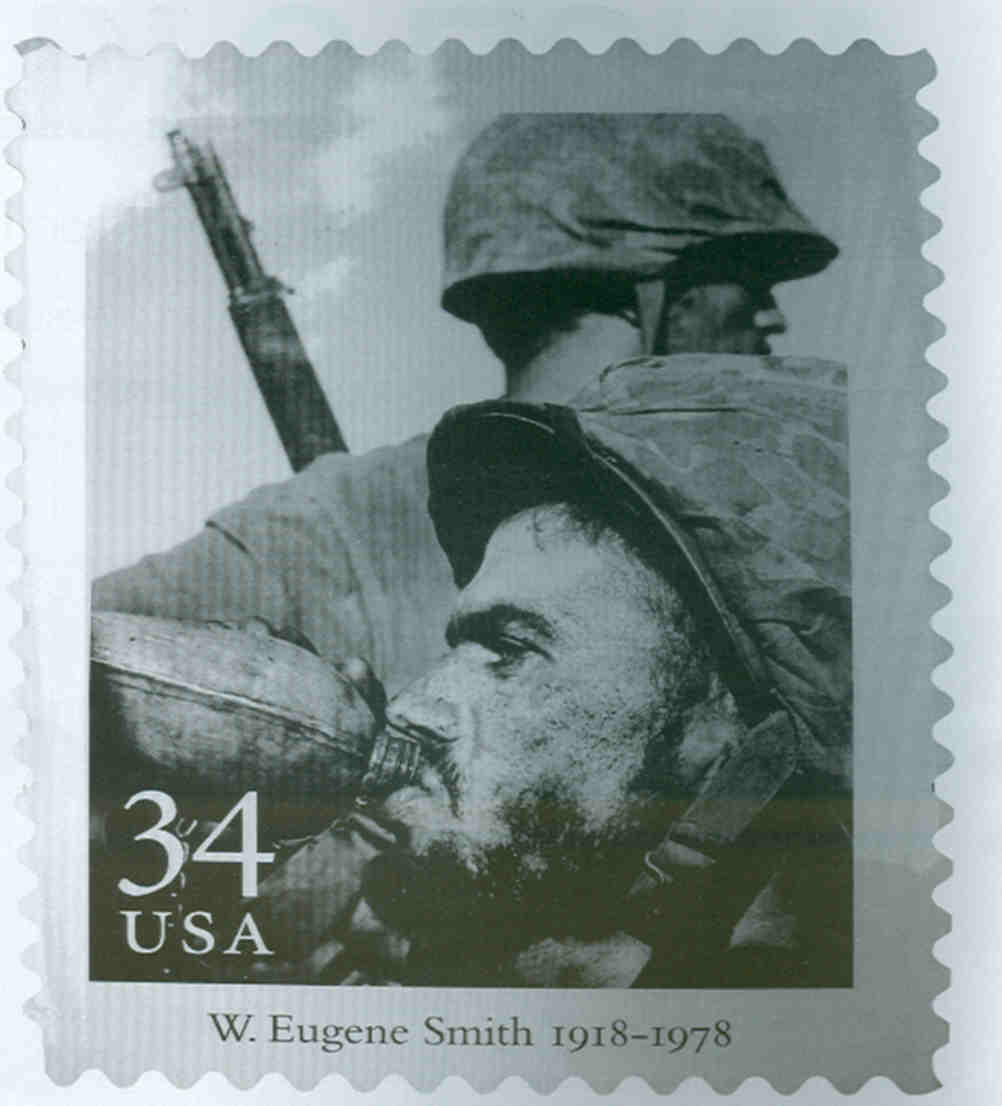 Stamps that was issued by the United States Post Office, featuring Angelo Klonis |
|
handcrafted elements as strong design details throughout. Everyone was obviously curious as to why he chose to build a house with Polynesian elements, but Angelo never revealed why nor how he was become inspired to do so. "Evangelo's" became the focus of life for the Klonis family, with the sons joining their parents after school and on weekends. Nick, then a young soccer star, remembers a day in 1972 when he told his father that he was to be photographed by someone from a sports magazine. When Angelo heard this, he quickly came out from behind the bar and with great enthusiasm said, "Find the picture the photographer from LIFE magazine took of me in the war!!" He told Nick that he thought it was published, that he had a cigarette in his mouth, but he'd never seen it. Something about Nick's forthcoming photo shoot with a magazine photographer clearly struck a chord with his father. |
|
|
|
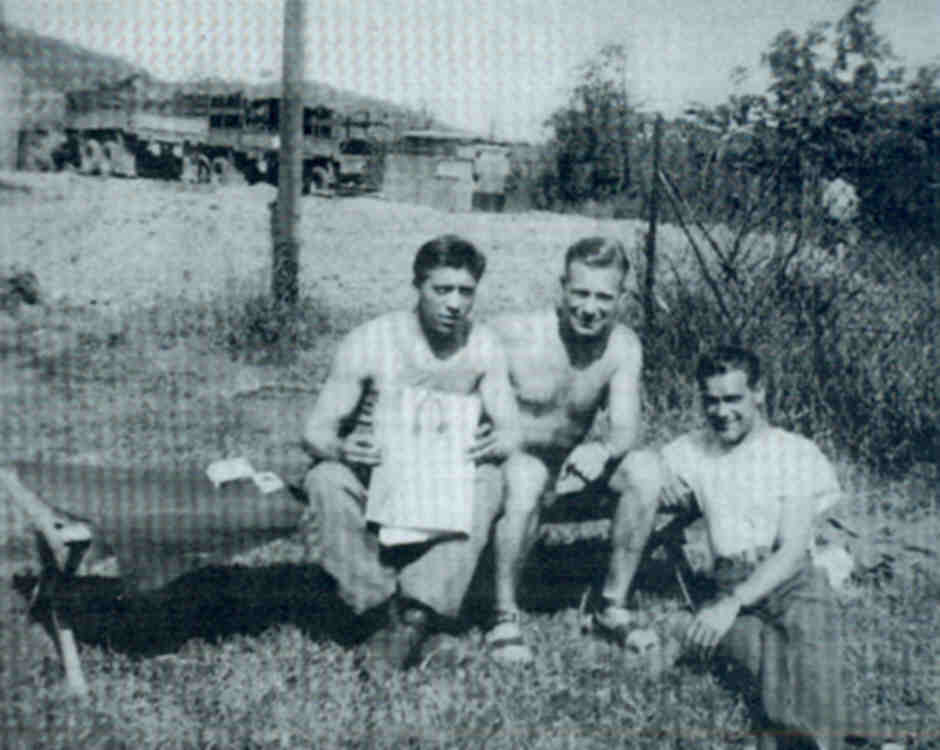 Three WWII soldiers sitting on a cot (L to R) "The Italian," John Ray Underwood and Angelo S. Klonis, take respite from the war |
| the image was credited to W. Eugene Smith. The Klonis family proudly displayed it at both Evangelo's and the Mediterrean Cafi, which they also owned in Santa Fe. Almost immediately, patrons began to mention how they loved that image, and how it was a favorite among those documenting America at war. The significance of the photograph was becoming clear; Angelo's likeness was known worldwide, representing to many who viewed it all the soldiers who fought in World War II. |
|
|
In 1998, Marcia Tiede, Curatorial Associate and Cataloger from the Center for Creative Photography (CCP) at the University of Arizona in Tucson, visited Santa Fe and stopped for lunch at the Mediterranean Cafi. |
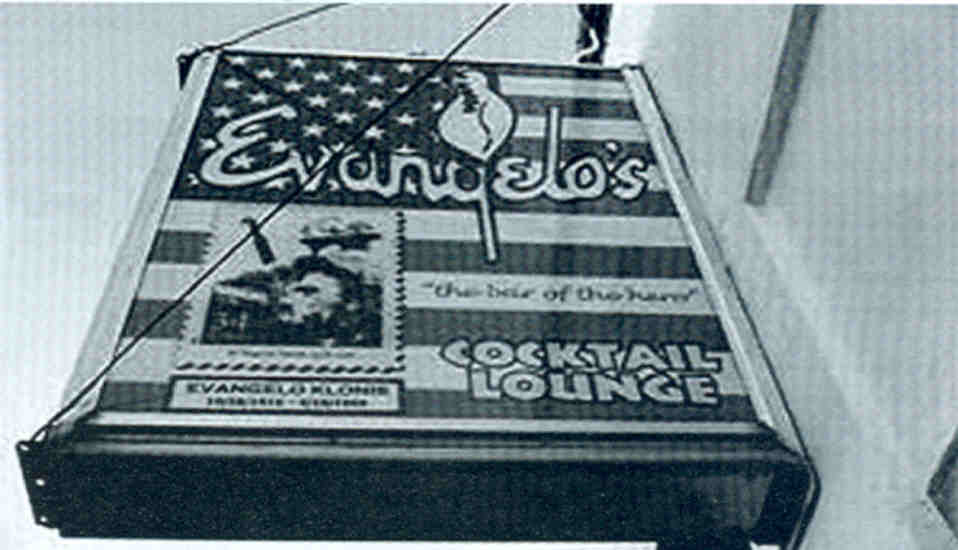 The family bar in Santa Fe, NM, today is operated by the hero's son Nick Klonis |
|
The CCP www.creativephotography.org holds the archive of photojournalist W. Eugene Smith with which Marcia was very familiar. Upon seeing the framed cover of the book featuring the Smith photograph, she asked the waitress why this was so prominently displayed and was told that the man featured in the photograph was the patriarch of the family that owned the restaurant. Within the same year, a project was to begin that would feature the Smith photograph; it was extremely fortuitous that a staff member at the CCP now knew where the soldier's family resided. In 1998, Peter C. Bunnell. McAlpin Professor of the History of Photography and Modern Art at Princeton University, was commissioned by the United States Postal Service to determine a set of 20 individual images that best depicted Masters of American Photography. This page of stamps was the final offering in the USPS' "Classic Collection:' and after four years of research and production was released with fanfare in June 2002; sixty million stamps were sold. In Bunnell's final selection, W. Eugene Smith was included among such notable photographic artists as Ansel Adams, Imogen Cunningham, Alfred Steiglitz and Minor White. He selected Smith's photograph of the WWII soldier drinking from a canteen as best representing his body of work. The USPS's path to find the Klonis family and secure the necessary model release, pre-publication, was not quite so simple, however. A business in Washington, D.C., called Photo Assist was contracted by the USPS Stamp Development Office to find the man featured in the Smith photograph in order to secure a model release. They contacted the CCP seeking permission, knowing Smith's farchive was housed there, and Ms. Tiede was able to tell them to contact The Mediterranean Cafl in Santa Fe and speak with the family of the soldier prominently depicted in the Smith photograph. The Klonis family shared with me a copy of a letter from Photo Assist to the USPS stating, "per Marcia Tiede, Curatorial Associate and Cataloguer at the CCP Library, the soldier's name is Evangelo Klonis." [NOTE: This letter, and other documents related to the publication of the Masters of American Photography, was obtained by the Klonis family though their attorney, Mr. Jere Corlett who filed for its release under the Freedom of Information Act through which they filed for access to documents in March of 2005.] |
|
|
Nick was informed of this project and told of the possible development of the photography stamp set and its confidentiality until its final approval. On September 14, 2001, the USPS requested the family's permission for Angelo's likeness to be featured in the Masters of American Photography stamp series, and was given a copy of the photograph with the canteen mocked up as a U.S. postage stamp, marked CONFIDENTIAL. The USPS asked Nick to verify that the man with the canteen was his father, which Nick confirmed and explained that more photographs of his father were in the Smith Archive at the CCP in Tucson. |
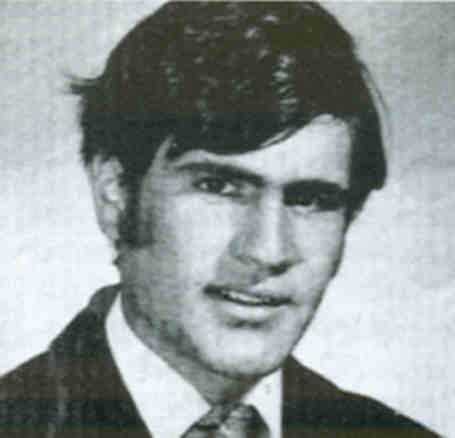 Angelo S. Klonis in his 20's |
| In 2002, Nick was again contacted by the USPS Stamp Development office and told the photography series was to be released and he could now reveal this to others. Nick was told "the Smith heirs anxiously awaited the Klonis family's permission to include this iconic Smith photograph in the Masters of American Photography series." They told Nick they did not have a budget to pay for the release, asking what might be acceptable to the family in exchange for their permission. They requested a set of firstedition stamps and the first poster to be released for marketing the series that featured the photograph of Angelo. The family excitedly awaited the publication of the American Photography series. On June 13, 2002, the USPS held a celebration for the release of the stamp set at the Museum of Photographic Arts in San Diego, where the family was represented by Angelo's son Demos. Upon receipt of the promised poster promoting the stamp series, Nick proudly installed it in Evangelo's, a companion to the cover of LIFE. Comments and queries from patrons increased, many asking about the location and circumstances surrounding the photograph. Nick became increasingly curious about his father's whereabouts during the war and began to research the authenticity of the caption. It was known at this point that Angelo was in Normandy during the early summer of 1944 (on Omaha Beach on DDay) and Smith was in the South Pacific at about the same time. Nick contacted the Army to have his father's military records released, only to learn that in 1973 a fire had destroyed all related documents at the Army facility in St. Louis where they were purported to be held. Having reached a dead end for confirmation by the military that Angelo was in Saipan at this crucial time, Nick resumed his search elsewhere. |
|
|
|
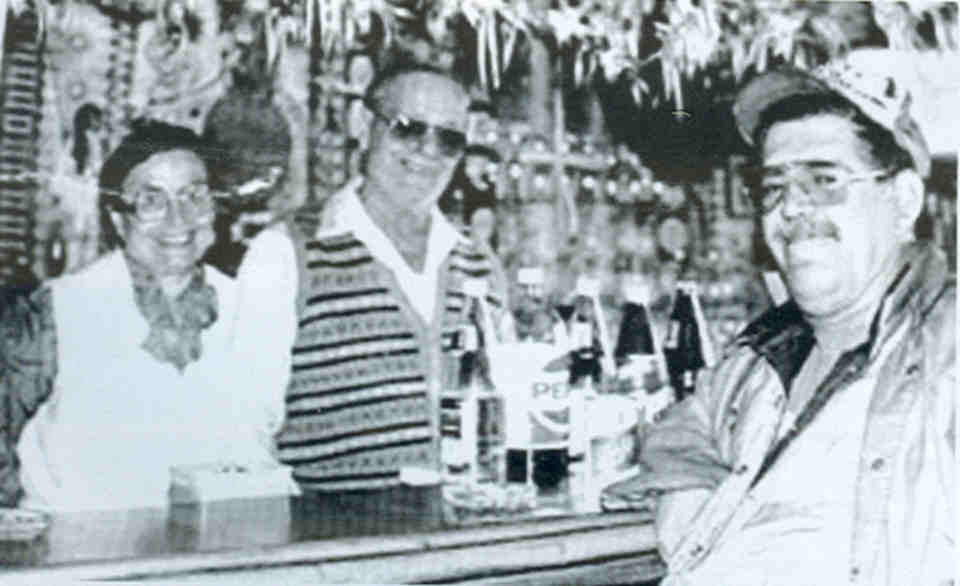 Angelo S.Klonis and his wife Angeliki ("Kiki") with an unidentified patron in their Santa Fe NM. bar, "Evangelo's" around 1980 |
|
Creative Photography where many of Smith's negatives and archive items are housed. Jackson thought Enyeart would be able to help Nick in his search for the facts about his father and the Smith photograph. |
|
|
Enyeart concurred that it appeared that the man in the Smith photographs was Nick's father. Nick explained that he needed to submit a letter from an expert to LIFE who would affirm this. Based on the documentation and materials he reviewed, Enyeart agreed to write a statement certifying this fact which was sent to the editors of the Time-Life Photo Library and Life magazine. Enyeart wrote, "I am unequivocally confident that the postal issue stamp of Smith's photograph is a portrait of Angelo Klonisn.". Shortly thereafter, Enyeart suggested to Nick that he was interested in exploring the idea of writing a book about the two Smith photographs. |
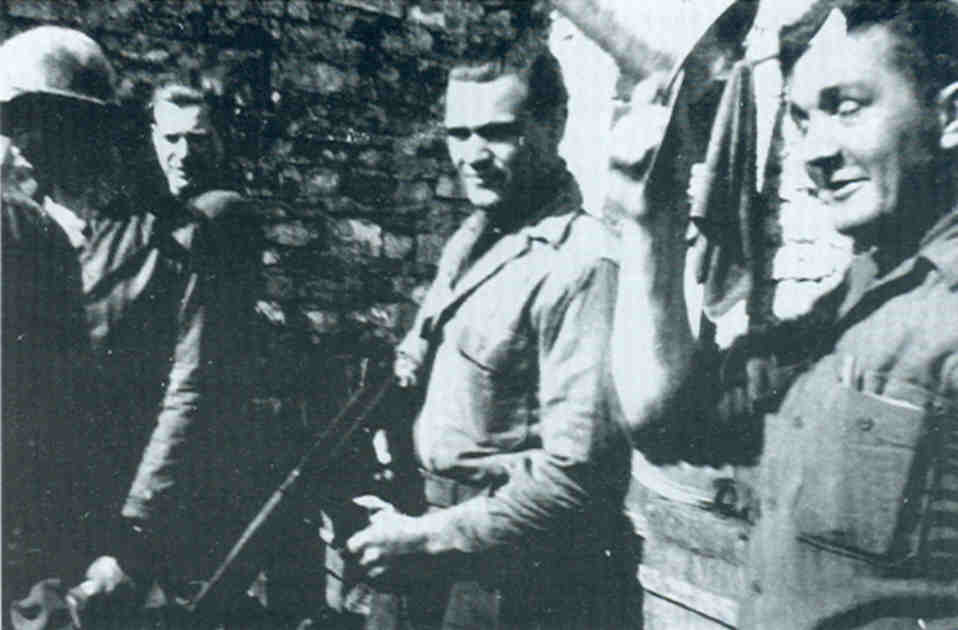 Nick Klonis holding Tompson machine gun in a special Rangers mission, with PFC John Ray Underwood on the right |
|
It was clearly documented that Smith had photographed in both Europe and Saipan, but Enyeart concluded that this discovery made it clear that the photographs were made in Saipan, not Normandy. However, evidence that Angelo was serving in the Pacific Theater had yet to surface. Enyeart was increasingly curious about just what this soldier was involved with on behalf of the U. S. Army. What missions had he been on? Why were there no records? Circumstances have prohibited Enyeart from continuing to research and write the book, but he noted recently that Nick's continued research on his father "appears to have born great benefit in the identity of the photographs." Spurred by Enyeart's scholarship and genuine interest in the project in late 2004 the family searched for more clues to his military whereabouts. Among Angelo's Army memorabilia, Kiki found a monetary note from the Japanese government that was typically issued to soldiers in the Pacific Theater. The family had never before seen this currency, located at the bottom of a metal box. This was their first indication that Angelo may in fact have been in Saipan! In early 2005, Enyeart made a second trip to the Center for Creative Photography to review and document the Smith contact sheets and notes from the film rolls featuring Angelo Klonis, particularly the full-frame image showing many people in the frame. |
|
|
Enyeart observed that Smith's film notes stated, "I believe that the images 6-8 on Roll on July 8, final days of Saipan Invasion, were 4th Division Marine PFC T.E. Underwood (24th Bat) of St Petersburg, Florida. A portrait of a weary warrior who has been through one of the toughest days of his life. And still at the moment the picture was taken under fire." Upon learning this, Nick strongly replied that it is his father in the image, not someone named Underwood! Nick notes that the man featured in the Smith photos is obviously a swarthy, darkskinned, dusky-looking Greek, not an Anglo. It is highly unlikely that he would have been an |
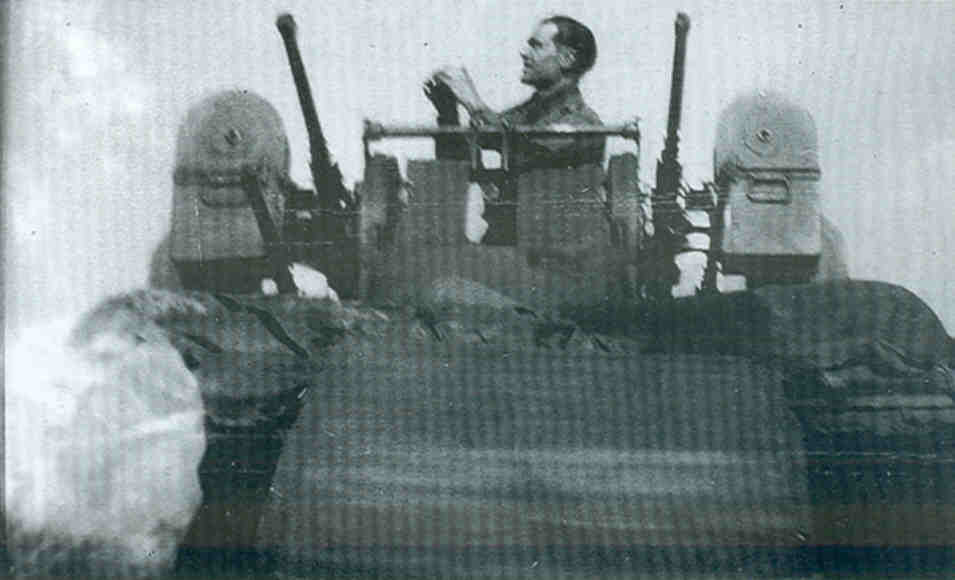 Nick Klonis on top of an anti-craft machine gun |
|
"Underwood" in the WWII generation of 55 years ago in America, when there was not as much intermarriage as there is today. "Remember," Jere Corlett says, "the armed forces were still segregated then." Nick telephoned Mrs. Underwood on April 1st to tell her of his discovery and asked if she knew anything about her husband's military experience and whereabouts during WWII. She said her husband spent most of his time in Europe, but served in some special missions in the Pacific, especially in Saipan where he was almost killed. As Underwood told the story, if he had to run 20 more yards he would have died were it not for his "Greek buddy" who saved his life. She shared that her husband had longed to see his friend again. He thought Angelo was from New Mexico, but did not know where and couldn't remember his last name. In 1978, she and her husband traveled west from Florida to New Mexico, getting as far as Albuquerque on their quest but alas they did not find his wartime companion. Throughout his lifetime, Underwood embraced all things Greek food, music - and fondly remembering his wartime friend. After listening to her passionate story, Nick replied, "Mrs. Underwood, I am calling you from New Mexico and I'm Greek!" The connection was made. Nick said he needed more time to look through his father's memorabilia in hopes of finding more photographs of her husband, calling her back with the news that "I think I have at least five photographs of your husband taken with my father!" Nick sent a selection to her to confirm, and she telephoned him right away to say, "Nick, the man with your father IS my husband!" Her husband was not "T E Underwood" however; she said her husband often talked about how he would change his first initials because he hated to say his name was J. R. as he was teasingly called "Junior." Nick thought about this comment and replied that his dad said his Army buddies used to call him "Crazy Greek," which translated as "TRELOS ELLlNAS" - 'T E." for short and going forward T.E. was used as his nickname. Hence, we have T. E. Underwood noted in the Smith film records - a mixture of the two friend's names. (Mrs. Underwood told him that her husband had emphasized that on special missions they were instructed never to give their real names, hence the initials.) Nick asked Mrs. Underwood if her husband talked to their family about his war years, explaining that his own father hadn't shared much and never discussed serving in the Pacific Theater. She graciously agreed to be interviewed for an affidavit and confirmed that she had learned from her husband that he and Angelo Klonis were on 13 secret missions together during their wartime service, including Saipan. Enyeart reviewed all the materials relating to the Underwoods and concluded the puzzle has been solved and no questions remained. Between Mrs. Underwood's statement and the comparison of the Underwood and Klonis family photographs featuring the other soldiers, along with review of the Smith negatives, Enyeart concluded that Nick's father was in Saipan on a secret mission and is unquestionably featured in the famous photograph known throughout the world. Enyeart has since identified a second soldier in the Smith photographs who also appears in Klonis' family snapshots, further substantiating that Klonis was in Saipan at the time W. Eugene Smith was photographing under contract for LIFE magazine. [NOTE Jere C. Corlett notes that "Enyeart was able to make the identifications of the unnamed soldiers in the different photos by viewing and comparing the individuals in an uncropped version of the Smith cigarette photo which is available only at the Center (CCP) in Tucson. The uncropped photo shows two more soldiers that are not seen in all of the cropped versions which are published all around the world. Underwood has never been identified in any of the Smith photos by anyone who has viewed them and compared them with other photos. The only reference to Underwood was by [W. Eugene] Smith himself in 1944, which we have now proven to be a wrong identification. But the irony is that Smith's mistake has led us to Underwood's widow 56 years later, and the widow has given us conclusive proof that Underwood was not in any of the Smith photos.] Nick informed the editors and archivists at the Center for Creative Photography and at LIFE magazine of Enyeart's conclusions. He again wished for the staff at LIFE to have confirmation from a respected member of the photography industry. Peter Howe, former Director of Photography for LIFE and Executive Editor of this e-magazine, was recently in Santa Fe to serve as a Portfolio Reviewer for Review Santa Fe www.sfcp.org. I participated as a Reviewer at the event as well, and took Howe on a pilgrimage to meet Nick at Evangelo's and see the evidence for himself. Howe enjoyed the visit and concurred on the positive identification of Angelo and the other soldiers, and has agreed to talk to his colleagues and further confirm that the subject in the Smith photograph is Mr. Angelo Klonis. Author's note: Since the time of Mrs. Underwood's April 15, 2005 affidavit Nick has found another clue - a photograph of a different soldier that appears in the Smith contact sheet as well as in the Klonis family album. It has furthered his interest in continuing to research the stories of his father's fellow soldiers featured in Smith's photographs, in hopes of bringing their stories to light. Angelo Klonis made immeasurable efforts to help the U.S. in the war effort; he died in 1989 never having viewed the photograph of himself that has become one of the most famous images of WWII. Here's hoping the Klonis family's efforts to learn of Angelo's legacy will inspire others to learn about their parent's war years. |
|
|
|
|
|
(Posting date 16 March 2007) HCS encourages readers to view other articles and releases in our permanent, extensive archives at the URL http://www.helleniccomserve.com/contents.html. |
|
|
|
|
2000 © Hellenic Communication Service, L.L.C. All Rights Reserved.
http://www.HellenicComServe.com |
|
